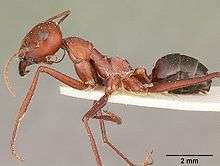Sahara Desert ant
| Sahara Desert ant | |
|---|---|
 | |
| C. bicolor worker | |
| Scientific classification | |
| Kingdom: | Animalia |
| Phylum: | Arthropoda |
| Class: | Insecta |
| Order: | Hymenoptera |
| Suborder: | Apocrita |
| Superfamily: | Vespoidea |
| Family: | Formicidae |
| Genus: | Cataglyphis |
| Species: | C. bicolor |
| Binomial name | |
| Cataglyphis bicolor Fabricius, 1793 | |
The Sahara Desert ant (Cataglyphis bicolor) is a desert-dwelling ant of the genus Cataglyphis. It inhabits the Sahara Desert and is one of the most heat tolerant animals known to date. However, there are at least four other species of Cataglyphis living in the Sahara desert,[1] for example C. bombycina, C. savignyi, C. mauritanicus and C. fortis.[2]
Background
Sahara desert ants are scavengers. They forage for the corpses of insects and other arthropods which have succumbed to the heat stress of their desert environment.
While no known land animal can live permanently at a temperature over 50°C, Sahara desert ants can sustain a body temperature well above 50 °C (122°F) with surface temperatures of up to 70 °C (178°F). Despite this, if out in the open, they must keep moving or else they will fry.
Navigation skills and internal pedometer
Measuring the sun's angle
This ant ventures far from its burrow in the Sahara Desert, which has almost no identifiable features. While venturing out it periodically takes measurements of its angle in respect to the Sun. By doing this the ant can venture far from its nest in search of food. Because of the blistering heat, it can only do this for about 3–5 minutes/day (the hottest time of the day, when all its predators are in hiding from the sun). When the ant finds a dead insect it then looks at the sun and because of its periodic references to the sun's angle it knows exactly what the shortest route back to the nest is. Researchers from the Max Planck Institute for Chemical Ecology have also verified that desert microhabitats have unique odour signatures that can guide the ants back to the nest.[3]
This skill, which has also been observed in the behavior of foraging honey bees, is elemental to the survival of this species of ant under the harsh conditions in which it lives. This behavior allows Cataglyphis to travel farther from its nest than any other creature that lives in the Sahara, with respect to size.
Pedometer
The ant appears to use an internal pedometer to count its steps in a harsh environment where odors quickly vanish, enabling it to "count back" to its nest.[4]
References
- ↑ Petrov, I. Z. (1986). "Distribution of species of the genus Cataglyphis Foerster, 1850 (Formicidae, Hymenoptera) in Yugoslavia" (PDF). Arhiv Bioloskih Nauka. 38: 11–12.
- ↑ Heusser, Daniel & Wehner, Rüdiger (2002): The visual centring response in desert ants, Cataglyphis fortis. The Journal of Experimental Biology 205: 585-590. Full HTML - PDF
- ↑ Steck, K.; Hansson, B. S.; Knaden, M. (2009). "Smells like home: Desert ants, Cataglyphis fortis, use olfactory landmarks to pinpoint the nest". Frontiers in Zoology. 6: 5. doi:10.1186/1742-9994-6-5. PMC 2651142
 . PMID 19250516.
. PMID 19250516. - ↑ Khamsi, Roxanne (29 June 2006). "Ants use pedometers to find home". New Scientist. Retrieved 5 May 2016.
External links
 Media related to Cataglyphis bicolor at Wikimedia Commons
Media related to Cataglyphis bicolor at Wikimedia Commons